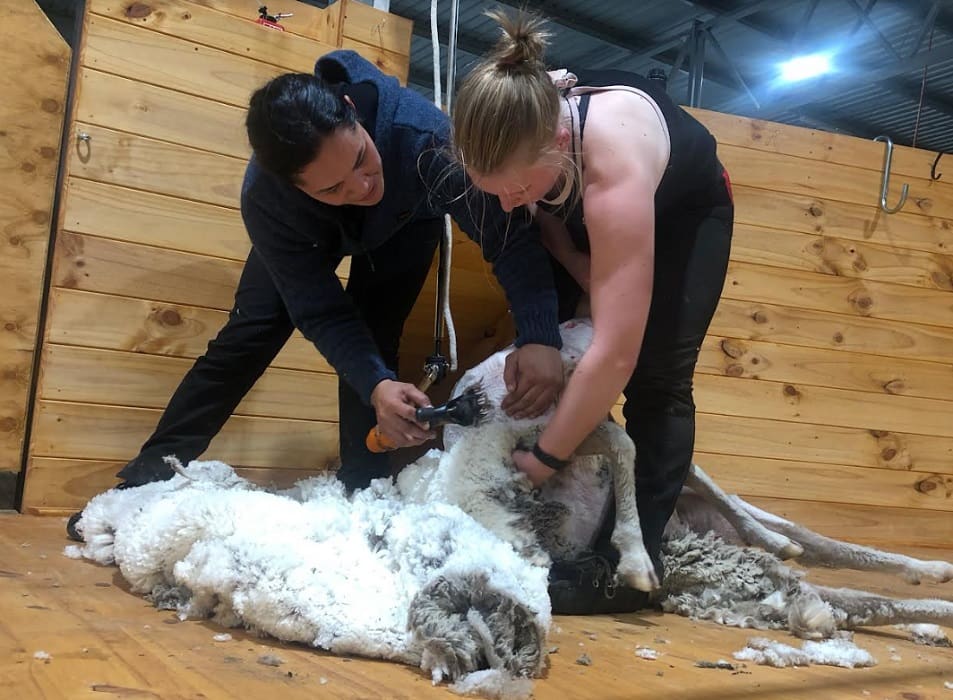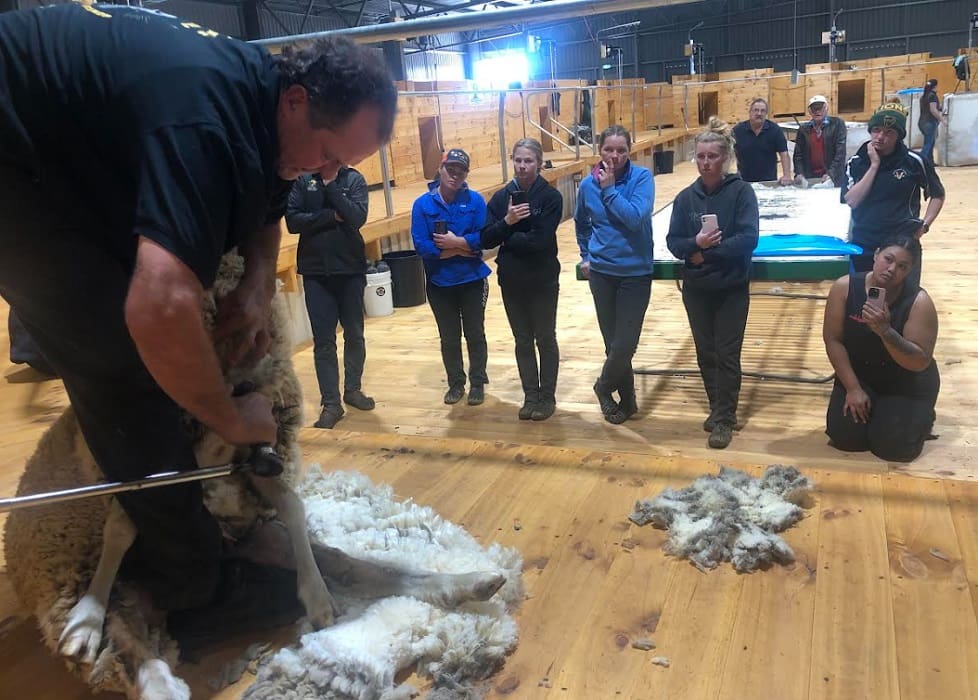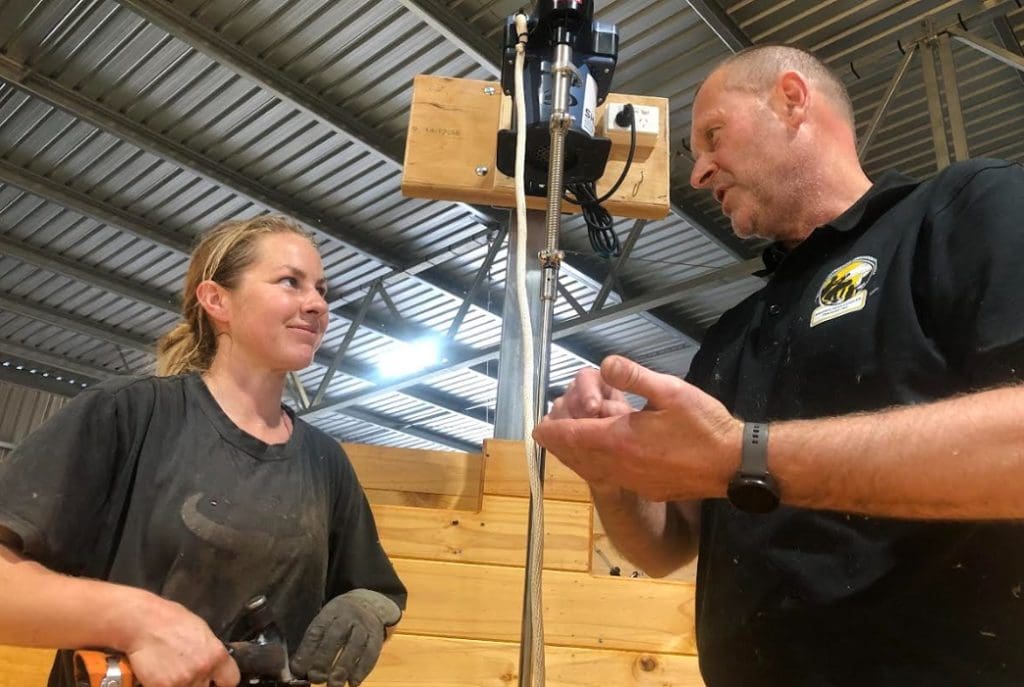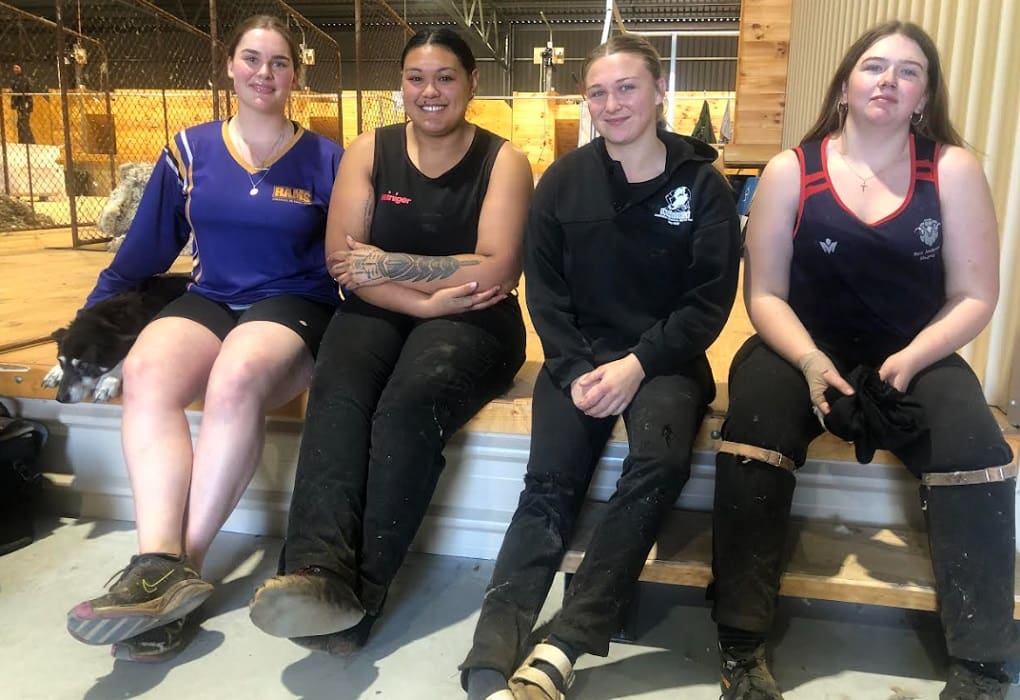
Catherine Mullooly gives Bordertown shearer Olivia Diment some tips on handpiece placement.
QUALITY was the key to keeping shearing jobs in the current more competitive environment, female shearers were told at a two-day Shear N Gear shearing workshop in north-west Victoria last week.
The shearers at the two-day workshop at the McBride family’s new 12-stand Telopea Downs shed was organised by SCAA Shearer Woolhandlers Training Inc with Australian Wool Innovation.
Australian and overseas shearers each got personalised training from former world champion Shannon Warnest, world record holder Catherine Mullooly from New Zealand, SWT advanced trainer Peter Oster and gear expert Klynt Correll.
The school attracted its maximum 20 participants within 24 hours of being advertised on Facebook and shearers came from throughout Australia, including some from overseas working in Australia.
Patience and equal opportunity
Catherine Mullooly said she liked to be able to give back some of the patience she was shown as she was learning shearing with mentors like Bart Hadfield and she applied this by adjusting her approach to shearers when giving advice.
“I like to give everyone a shot, an equal opportunity, everyone learns different.”
She said women are becoming more accepted on shearing teams, but she never saw herself as the woman in a team, just wanting acceptance as a part of the team.
“I really couldn’t wait until I was seen as not just as the girl and definitely not seen as a disadvantage.”
She had never been to a women’s shearing school before but could see the advantages helping to ease the innate nervousness of the participants.
Focus on quality to keep your job

Former world record shearer Shannon Warnest demonstrates for the workshop participants.
After showing the shearers how to set up flat surfaces on their sheep for cleaner strokes with positioning and handling, Shannon Warnest said producers were now more focused on the job being done by shearers.
He said there is a big change in shearing job market, with a focus on quality as producers moving out of sheep or into shedding sheep meant more shearers competing for positions.
“I’ve seen a big swing in the last 6-8 years, with this bit of drought, few less numbers and plenty of people around, your job is going to be out there to look at.
“When they shut the gate (on your count out pen) you can’t hide your job, the stuff we are showing you, you can do it at world record level,” he said.
He told the shearers the job they did would not “tell you lies” and he advised the shearers to go out back and look at their sheep in the counting out pens.
“Don’t worry about those little bits, it’s those big bits that add up to a lot real quickly
So have a look at your job; if you’re flanking them — leaving a patch of wool on every flank – well once that disappears then the next biggest mistake will stick out to you and then you work on that and all of sudden you are shearing every sheep spot on.”
Untapped potential for more female shearers

Swedish shearer Marlie de Beer with SWTI CEO Glenn Haynes.
SCAA Shearer Woolhandlers Training Inc chief executive officer Glenn Haynes said female shearers take the attention to detail they applied in wool handling into their shearing, whereas male shearers tend to focus on speed and then quality.
“The girls are the other way around, they’ll take their time to get their quality and all the basics right and then they’ll go for the speed.”
Having a quality female shearer in a team helps lift the quality of all the shearers in a team, he said.
“And that’s what we want to see in a team.
“Everyone wins from quality whether it’s the stock agent, the wool broker, the processor and the farmer, so that’s the main aim.”
He said Catherine Mullooly is a good role model, looks after herself, came back to shearing as a mother and “tells the whole story” for the young shearers.
“She’s exceptional in big sheep, she’s shorn in Australia, she’s got all the experience.”
Mr Haynes said the industry has not tapped the full potential for women working as shearers. More women gained pens when COVID cut shearer numbers in teams and then contractors started contacting SWTI seeking young female shearers. Now contractors were starting to “pick and choose” workers on the quality of their work, he said.
“I don’t know any contractors who aren’t saying they have a glut of workers ringing them and a lot of that is seasonal conditions, lower wool prices and some shearers charging too much and farmers making a decision to do something else.
“It’s the case now that if you rock up and do a quality job without dramas that’s what people want.”
To retain female shearers, the industry needs to encourage them and keep getting new people involved to replenish those leaving. He said contractors prepared to take on learners into stable teams with a professional attitude, sustainable run and good sheds are reaping the rewards and the young women are looking for them, Mr Haynes said.
“On facilities, the McBrides will never have a problem getting workers here.”
It’s about skills and inspiration

At the shearing workshop, from left, were, Milly the Kelpie, wool handler Aleisha Rintoule, and shearers Keilani Filoa, Lexi Armistead and Isabella Ticehurst.
Lexi Armistead, 21 from Colac, is a new SWTI ambassador and has been shearing for 18 months, carrying on the trade of her mother Tania. Lexi handled wool for 18 months before starting shearing.
“I just loved the lifestyle, being able to travel with that and then I liked the idea with shearing of being able to push myself each day to find my limits.
“To work as hard as I wanted to and be paid for as hard as you want to work.”
Lexi said the money is an attraction.
“But it can’t be the only attraction because it is so difficult.
“It’s physically hard and mentally as well, but it’s getting easier on my body and in my head.”
Lexi’s height is about 168cm and many of the sheep she is shearing are heavier than her, meaning she had to focus on her technique, footwork and hand positioning.
She was keen to get tips from the experienced instructors, especially world record holder Catherine Mullooly, who returned to shearing after having two children and set a new solo women’s eight-hour strong wool ewe record of 465 ewes in January.
“She is really inspiring.”
Lexi did her first 300 crossbred ewes in a day earlier this year, but has had a quick progression, shearing her first 100 sheep a week after her first school and six months later did 200 in Merinos.
She said it is hard for young women to get a shearing stand, especially if they are working as wool handlers, because of the shortage of good roustabouts.
“When I started hearing, my contractor didn’t want to give me a stand because he didn’t have anyone to cover my spot as a wool handler.”
But she said women bring to shearing the same attention to detail they applied in wool handling and the industry could encourage more female shearers by improving the attitudes of contractors and better facilities.
“There are definitely a lot more women getting into shearing now and there not many teams now that wouldn’t have at least one full-time female shearer.”
Tasmanian shearer and ambassador Emily Spencer said she was attracted by the experience of the instructors. The 20 year-old has been shearing for 2.5 years and would like to some days attempt a shearing record. She said having female shearers like Catherine Mullooly in the industry will inspire other women to take up shearing.
Queensland shearer Grace Schoff said with women’s shearing schools and women breaking records would attract more women.

Really well done, focusing on the quality of shearing and not only the amount of sheep shorn is the future, with rising costs for producers.